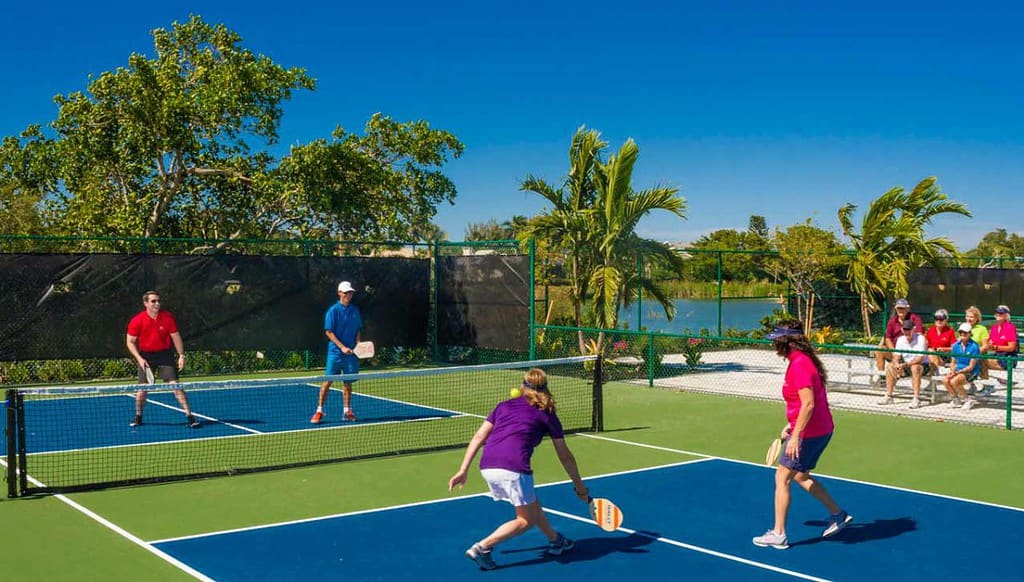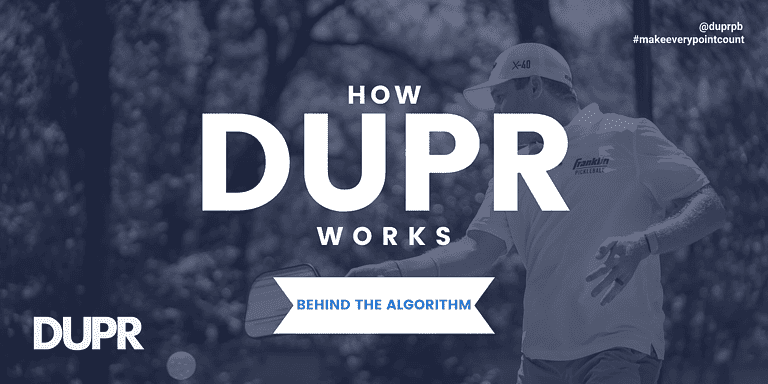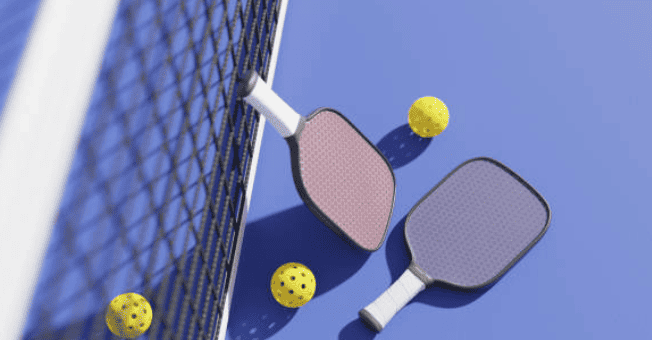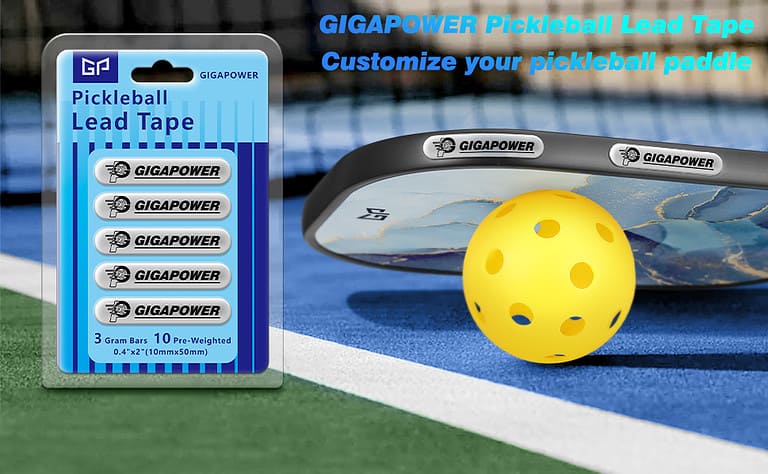Swing Speed in Pickleball: How To Achieve Optimal Performance
Swing speed is an essential aspect of any pickleball player’s game. It refers to the speed at which a player swings their paddle to hit the ball. The faster the swing speed, the more power you can generate, which can translate into a harder-hit ball.
We see it all the time in the Pro Tournaments we watch with our favorite players, and they drive and volley the ball fast and hard. Your swing speed will also continue to get faster as you play more. A beginner’s swing speed will usually be less than an advanced player.
Having a fast swing speed can be an advantage in many situations. For example, it can help you hit the ball harder, which can make it more difficult for your opponents to return.
Additionally, a fast swing speed can help you hit the ball with more accuracy, which can make it easier to place the ball in the desired location on the court.
However, it is important to note that swing speed is not the only factor that determines your success on the court. Other factors, such as footwork, strategy, and shot selection, are also important to consider. You need them all.
Understanding Swing Speed in Pickleball

As a pickleball player, understanding swing speed is crucial to improve your game. Swing speed refers to the velocity at which a player strikes the ball with their paddle. It is an essential factor that determines the power, accuracy, and control of your shots.
What is Swing Speed?
In pickleball, swing speed is not just about hitting the ball as hard as possible. It is more about finding the right balance between power and control. A fast swing speed can generate more power, but it can also result in less accuracy and control.
On the other hand, a slower swing speed can provide more control, but it may not generate enough power to put your opponent on the defensive.
I had issues initially when I started because I hit the ball with a short jerky-type motion. And while it worked well in some situations, many times, the ball just went into the net.
So, the optimal swing speed in pickleball depends on several factors, including your skill level, playing style, and physical abilities. A beginner player may benefit from a slower swing speed to focus on control and accuracy, while an advanced player may need a faster swing speed to put their opponents under pressure.
Can Swing Speed be Improved?
To improve your swing speed in pickleball, you need to work on your technique, footwork, and timing. A proper technique involves using your entire body to generate power and momentum while maintaining control over the shot.
Footwork is also crucial to get in the right position to hit the ball with the right swing speed. Timing is essential to hit the ball at the right moment to generate maximum power and accuracy. This really does take practice and drilling.
In conclusion, swing speed is an essential factor in pickleball that can make a significant difference in your game. By finding the right balance between power and control, you can improve your shots and put your opponents under pressure. To improve your swing speed, focus on your technique, footwork, and timing, and practice regularly to develop muscle memory and consistency.
What is The Role of the Paddle in Swing Speed?
As a pickleball player, I know that the paddle is an essential piece of equipment that can greatly impact my game. In this section, I will discuss the role of the paddle in relation to swing speed and how it affects your gameplay.
Choosing the Right Paddle
Choosing the right paddle is crucial when it comes to swing speed. The weight of the paddle is a significant factor in determining how fast you can swing it. A lighter paddle is easier to swing, allowing you to generate more speed. However, a heavier paddle provides more power and stability, which can be beneficial in certain situations.
Paddle Weight Overview
| Weight Range | Power | Spin | Control | Agility |
|---|---|---|---|---|
| Lightweight (7-7.3 ounces) | Best for agility and control | Good for spin | Good for touch shots | Beginner Intermediate 50+ Women Doubles Play |
| Midweight (7.3-8.3 ounces) | Good balance of power and control | Good for all-around play | Good for volleys | Versatile |
| Heavyweight (8.3-10 ounces) | Best for power | Good for blocking | Less forgiving on mis-hits | Singles Beginner Intermediate Advanced |
| Extra Heavy (10-13 ounces) | Maximum power | Not as good for spin or control | Very unforgiving on mis-hits | Advanced |
It’s important to find a paddle that fits your playing style and preferences. The length of the handle, the grip size, and the shape of the paddle can all affect your swing speed and how comfortable the paddle feels in your hand.
Paddle Shape Overview
| Shape | Length (inches) | Width (inches) | Total Length + Width (inches) |
| Standard | 15.75 – 16.5 | 7.5 – 8.25 | 24 |
| Elongated | 16.5 – 17 | 7 – 7.5 | 24 |
| Widebody | 16 – 16.5 | 8.25 – 8.5 | 24 |
| Control | 15.5 – 16 | 7.75 – 8 | 24 |
Grip Size & Length Overview
| Grip Size | Circumference | Grip Length | Benefits |
|---|---|---|---|
| Small (4-4.125 inches) | Narrowest grip | Short (<5 inches) | Provides more wrist mobility and control, ideal for players with smaller hands or who prefer a more touch-oriented game. |
| Medium (4.25-4.375 inches) | Standard grip | Standard (5 inches) | A good all-around grip size that is comfortable for most players. |
| Large (4.5-4.625 inches) | Widest grip | Long (>5 inches) | Provides more stability and power, ideal for players with larger hands or who prefer a more aggressive game. |
Is the Swing Weight of the Paddle Important?
Swing weight is another critical factor in determining the speed of your swing. Swing weight is the measure of how heavy the paddle feels when you swing it. It is affected by the weight of the paddle and its distribution. A paddle with more weight in the head will have a higher swing weight, making it harder to swing quickly.
To improve your swing speed, it’s essential to understand the swing weight of your paddle. You can do this by swinging your paddle normally, then turning it around and swinging it from the top of the paddle.
You should be able to tell a difference in the weight of the paddle each time. By finding a paddle with a lower swing weight, you can increase your swing speed and generate more power.
Finding the Sweet Spot

The sweet spot is the area on the paddle where you can hit the ball with the most power and control. It’s important to find the sweet spot on your paddle to maximize your swing speed and accuracy.
A paddle with a smaller sweet spot may require more precision and control to hit the ball effectively, while a larger sweet spot can provide more forgiveness and power. There are training aids to help you consistently hit the paddle sweet spot.
Overall, your paddle does play a significant role in determining your swing speed and overall gameplay. By choosing the right paddle, understanding the swing weight, and finding the sweet spot, you can improve your swing speed and take your game to the next level.
How Can You Improve Your Swing Speed? Techniques and Tips

As a pickleball player, improving your swing speed is crucial to winning games. In this section, I will discuss some techniques that can help you increase your swing speed.
Correct Grip and Backswing
Having the correct grip and backswing is essential to generating more power and speed in your swing. A proper grip should be firm but not too tight, allowing you to control the paddle and generate more power. The backswing should be short and compact, with the paddle close to your body. This allows for a quick and explosive forward swing.
Balance and Positioning
Maintaining good balance and positioning is crucial to generating more power and speed in your swing. You should always be in a balanced position with your feet shoulder-width apart and your weight evenly distributed. This will allow you to transfer your weight from your back foot to your front foot during the swing, generating more power and speed.
Your positioning on the court is also important. Positioning yourself closer to the ball will allow you to generate more power and speed in your swing, as you won’t have to reach as far to hit the ball.
Focus and Direction
Focusing on the ball and the direction of your swing is important to generate more power and speed. You should always keep your eyes on the ball and focus on hitting it in the direction you want it to go. This will allow you to make better contact with the ball, generating more power and speed in your swing. I had a coach that drilled into me, ‘You should be able to read the name of the ball every time’.
The arc of your swing is also important. A higher arc will generate more power and speed, while a lower arc will generate less power and speed. You should experiment with different arcs to find the one that works best for you.
Improving your swing speed is crucial to winning games in pickleball. By using the techniques discussed in this section, you can increase your swing speed and become a better player.

Swing Speed and Shot Types
Swing speed is an important factor in determining the type of shot you can hit. The speed at which you swing your paddle can affect the power and placement of your shots. In this section, I will discuss the different shot types and how swing speed can impact them.
Drop Shots and Smash Shots
Drop shots and smash shots are two of the most common offensive shots in pickleball. A drop shot is a soft shot that lands just over the net and bounces low, while a smash shot is a hard shot hit downward with a lot of power.
When hitting a drop shot, it’s important to have a slow and controlled swing. This allows you to hit the ball with finesse and place it exactly where you want it. On the other hand, when hitting a smash shot, you need to have a fast and powerful swing. This generates the force needed to hit the ball hard and fast, making it difficult for your opponent to return.
Backhands and Groundstrokes

Backhands and groundstrokes are two common types of shots in pickleball. A backhand is a shot hit on the non-dominant side of your body, while a groundstroke is a shot hit after the ball has bounced on the ground.
When hitting a backhand, it’s important to have a smooth and fluid swing. This allows you to generate enough power to hit the ball while also maintaining control of the shot. When hitting a groundstroke, you need to have a fast and powerful swing. This generates the force needed to hit the ball hard and fast, making it difficult for your opponent to return.
So, swing speed is an important factor in determining the type of shot you can hit in pickleball. Whether you’re hitting a drop shot or a smash shot, a backhand, or a groundstroke, the speed at which you swing your paddle can have a big impact on the outcome of the shot. By understanding the different shot types and how swing speed can impact them, you can improve your game and become a more effective pickleball player.
Strategy and Swing Speed
As a Pickleball player, I understand the importance of strategy in winning games. One crucial aspect of the strategy is swing speed. In this section, I will discuss how swing speed can be used to set up the point and apply pressure on the opponent.
Setting up the Point
Swing speed plays a significant role in setting up the point. When serving, it is essential to consistently serve deep, to backhands, and in the court to force the opponent to hit a defensive return. This strategy gives me an opportunity to hit an offensive shot on the third shot and gain control of the point.
Another way to set up the point is by hitting a hard and low shot towards the opponent’s feet. This shot is challenging to return, and it forces the opponent to hit a defensive shot, which I can then use to hit an offensive shot.
Applying Pressure on the Opponent
Swing speed can also be used to apply pressure on the opponent. When hitting an offensive shot, I try to hit the ball hard and fast to make it challenging for the opponent to return. This strategy puts the opponent under pressure and forces them to hit a defensive shot, which I can then use to hit another offensive shot.
Another way to apply pressure on the opponent is by hitting a shot with a lot of spin. This shot makes it difficult for the opponent to return, and it forces them to hit a defensive shot, which I can then use to hit an offensive shot.
In conclusion, swing speed is an essential aspect of strategy in Pickleball. By using swing speed to set up the point and apply pressure on the opponent, I can gain control of the point and increase my chances of winning the game.
Learning Resources
Learning how to improve your swing speed in pickleball can be challenging, but there are numerous resources available to help you. Here are some of the best resources for learning how to improve your swing speed in pickleball.
Video Lessons and Instructions
Watching videos can be a great way to learn new techniques and get tips on how to improve your swing speed. There are many online resources available that offer video lessons and instructions on pickleball techniques.
Pickleball Apps
There are several pickleball apps that provide tutorials and instructions. These are great and convenient ways to learn at home or on the court. Several pickleball Pros have training apps to help players improve their game. Learn more in our article on The 12 Best Pickleball Apps.
Drills and Practice
Practicing your swing speed is essential if you want to improve. Fortunately, there are many drills and practice routines that you can use to improve your swing speed.
One great drill is the “shadow swing” drill. This drill involves practicing your swing without a ball. Simply stand in front of a mirror or a wall and practice your swing, focusing on your form and technique.
Another great drill is the “drop and hit” drill. This drill involves dropping a ball and hitting it as it bounces up. This drill can help you improve your reaction time and your swing speed.
Common Mistakes and How to Avoid Them
When it comes to swing speed in pickleball, there are a few common mistakes that players make. These mistakes can cause inconsistency, inaccuracy, and slow reaction times, which can ultimately lead to losing points. In this section, I will discuss some of the most common mistakes and how to avoid them.
Mistake #1: Over-Swinging
One of the most common mistakes that players make is over-swinging. Over-swinging occurs when a player swings their paddle too far back before making contact with the ball. This can cause a slower reaction time and a less accurate shot. To avoid over-swinging, focus on keeping your swings short and compact. Practice hitting the ball with a shorter backswing until it becomes natural.
Mistake #2: Hitting Out of Bounds
Another common mistake that players make is hitting the ball out of bounds. This can be frustrating, as it results in a lost point. To avoid hitting out of bounds, pay attention to your footwork and positioning. Make sure you are in the correct position to hit the ball and aim for the center of the court. Additionally, practice hitting with different levels of power to get a better feel for how hard you need to hit the ball to keep it in bounds.
Mistake #3: Non-Volley Zone Violations
A common mistake that beginners make is stepping into the non-volley zone when they shouldn’t. This can result in a fault and a lost point. To avoid this mistake, practice your footwork and positioning. Make sure you are aware of where the non-volley zone is, and stay behind the line until you are allowed to step inside.
Mistake #4: Lack of Consistency
Consistency is key in pickleball. A lack of consistency can lead to lost points and frustration. To improve your consistency, focus on hitting the ball with the same amount of power and spin each time. Additionally, practice hitting the ball in different directions and at different speeds to improve your overall control.
Mistake #5: Inaccuracy
Inaccuracy is another common mistake that players make. This can be caused by a variety of factors, such as over-swinging, lack of focus, or improper footwork. To improve your accuracy, focus on hitting the ball in the center of your paddle. Additionally, pay attention to your footwork and positioning to make sure you are in the correct position to hit the ball accurately.
By avoiding these common mistakes, you can improve your swing speed and ultimately become a better pickleball player. Remember to focus on your technique, footwork, and positioning to improve your consistency, accuracy, and reaction time on the court.
Swing Speed for Beginners

As a beginner in pickleball, it is important to understand what swing speed is and how it affects your game. Swing speed is the velocity at which you swing your paddle to hit the ball. It is a crucial factor in determining the direction, distance, and power of your shots.
When you are starting out, it is natural to focus on hitting the ball with all your might. However, this can lead to poor shot placement and control. Instead, focus on developing a consistent swing speed that allows you to hit the ball accurately and with control.
One way to improve your swing speed is to practice your footwork. Make sure your feet are in position before attempting to swing. Step back, to the side, or forward so that the ball is positioned slightly ahead of your body when you make contact. This will give you more time to prepare for your shot and generate more power in your swing.
Another important aspect of swing speed is spin. The amount of spin you put on the ball can greatly affect its trajectory and bounce. As a beginner, focus on developing a consistent swing that produces a flat shot. Once you have mastered this, you can start experimenting with different types of spin, such as topspin and backspin.
In addition to footwork and spin, it is important to develop good paddle control. This means being able to adjust your swing speed and angle to hit the ball where you want it to go. As a beginner, start by practicing your shots from different positions on the court. This will help you develop a feel for how your paddle interacts with the ball and how to adjust your swing accordingly.
In summary, swing speed is a crucial factor in pickleball and can greatly affect your game. As a beginner, focus on developing a consistent swing speed that allows you to hit the ball accurately and with control. Practice your footwork, develop good paddle control, and experiment with different types of spin to take your game to the next level.
Frequently Asked Questions
What is swing weight in pickleball paddles?
Swing weight is the measure of how heavy a paddle feels when it is swung. It is determined by the weight distribution of the paddle. A paddle with a higher swing weight will feel heavier when swung than a paddle with a lower swing weight.
How does pickleball swing weight affect gameplay?
Pickleball swing weight can affect gameplay in a number of ways. A paddle with a higher swing weight can generate more power and momentum but may be more difficult to maneuver quickly.
A paddle with a lower swing weight will be easier to maneuver quickly but may generate less power. The ideal swing weight for a player will depend on their individual playing style and preferences.
Can the swing weight of a pickleball paddle be adjusted?
The swing weight of a pickleball paddle can be adjusted by adding lead tape.
What is the difference between pickleball and tennis swings?
Pickleball swings are generally shorter and more compact than tennis swings. In pickleball, players often use a wrist snap to generate power, while in tennis, players use a full arm swing. Additionally, pickleball paddles are smaller and lighter than tennis rackets, which affects the swing weight and overall feel of the swing.
How does spin affect pickleball gameplay?
Spin can greatly affect the trajectory and bounce of the ball, making it more difficult for opponents to return. Topspin can cause the ball to bounce higher and move forward, while backspin can cause the ball to bounce lower and move backward. Sidespin can cause the ball to curve in different directions.
What is the fastest recorded pickleball serve by a professional player?
The fastest recorded pickleball serve by a professional player is 87 mph, achieved by Tyson McGuffin in 2018. However, the average serve speed for professional players is typically between 55-65 mph.







